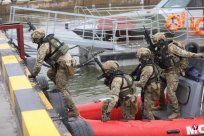This small double rotor drone performed the first flight task on the surface of the Mars, with a flight height of 3 meters, and maintained a stable suspension for 30 seconds, then landed, 39.1 seconds before and after.This lift helps to pave the way for the air exploration mode of Mars and other celestial bodies in Mars and the solar system.
(Washington Composite Electric) NASA's Witail unmanned helicopter successfully completed the first flight on Mars.Although it rose only 3 meters and hovered for 30 seconds, because Mars' environment and conditions were completely different from the earth, this was a major breakthrough in technology.NASA described the first breakthrough of the Writt Brothers for the first test flight of the Wright Brothers in 1903.
After the flight was successful, the Astronautical Bureau stated that at 3:34 am on the 19th of the Eastern Time (3:34 pm in Singapore), this small double rotor drone performed the first flight on the surface of the Mars on the surface of Mars.The mission, the flight height is 10 feet (3 meters), and maintains a stable suspension for 30 seconds, and then landed, 39.1 seconds before and after.At 6:46 am on the same day, the data transmitted to the earth through the Perseverance Martian detector through the perseverance, showing that the drone completed the first flight task.
The first task of this test flight is not a scientific investigation, but to test whether the aircraft "can fly" on Mars.Flying on Mars needs to deal with multiple challenges such as thin atmosphere, violent wind, extremely low temperature, deep space radiation, and environmental gravity.This dozens of seconds of lifts help to pave the way for the air exploration mode of Mars and other celestial bodies in Mars and the solar system, including Venus and Saturn's satellite Titan.
According to the Astronautical Bureau, this double -rotor drone weighs about 4 pounds (about 1.8 kg). The fuselage with only paper tissue boxes is loaded with computer -based computers, lithium batteries, sensors and cameras.It also carries a solar cell board to charge lithium batteries, which is enough to support the daily flight of each Mars, 90 seconds each, a flight distance of up to 300 meters and a maximum of 5 meters.
The drone blades are four times faster than rotating on the earth
On February 18 this year, it landed on Mars by Jiuli Mars, and then a series of tests and preparations were for the remote control of the Aerospace Bureau. It was landed on April 3.
Mars is much thinner than the earth, and the density is less than 1%of the earth. The withered rotor must rotate at a higher speed.On the earth, the propeller blades of the helicopter have an average of 400 rpm per minute per minute, and the withered leaves are 2500 rpm per minute.Its landing point at night can be as low as minus 90 degrees Celsius at night.
The two cameras on the perseverance recorded the first flight process of the wit, and transmitted images and other data back to the earth of 278 million kilometers after nearly three and a half hours.
At that moment, the people in the Aerospace Jet Promotion Lab near Los Angeles reported on the laboratory in Los Angeles.They worked hard for this task for six years in this laboratory.
The director of the Jet Promotion Laboratory, Watkins, said that the Wivoty project has taken more than six years from the implementation of feasibility study to the implementation of engineering concepts to the end of the project concept.
Weng Mimi, director of the witty project of Jet Promoting Laboratory, said: "We can now say that humans have flew across the aircraft on another planet."
April 22, American time Will do the second test flight
The Aviation Administration compared the achievement to the first controlled flight near Kyotothock, North Carolina, in December 1903 in December 1903.The first aircraft completed the take -off and landing within 12 seconds, with a flight distance of 120 feet (36.6 meters).
The Agent Director of the Astronomical Bureau, Yulzik, said at the briefing: "This is indeed the time of the Leit brothers."
TheThe Aviation Bureau's mission team will continue to receive and analyze the data and images of the first test flight of the machine wisdom, and formulate a plan for the second test flight on April 22.


